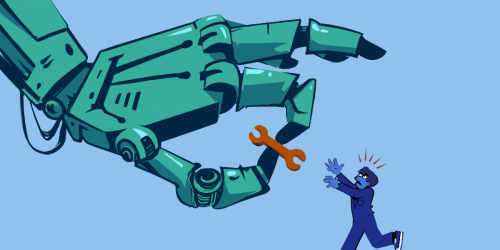In January 2020, former New York City Mayor Bill de Blasio announced New York City’s Internet Master Plan, setting a path to deliver broadband for low-income New Yorkers by investing in public fiber infrastructure. The plan was a clear response to the gap created from systemic digital redlining (an industry practice EFF has called for governments to ban) that every American city deals with today. Shortly after the announcement by de Blasio, the COVID-19 pandemic hit and the made the need for public fiber into low-income areas greater than ever before.
In response, former union workers at Spectrum opted to build their own broadband cooperative called People’s Choice Communications, to deliver free high-speed access. This was unequivocally a good thing. The de Blasio Administration itself was even in the process of contracting with the worker-owned cooperative to build new networks. But since the election of Mayor Eric Adams, this critical progress has not only come to a halt, it is also now actively being undermined, to the benefit of large cable corporations. Instead of pursuing long term solutions to low-income access, as outlined by the Internet Master Plan, Mayor Adams has abandoned that plan. Now, the Adams administration is pushing an extraordinarily wasteful proposal dubbed “Big Apple Connect,” that literally just hands money over to cable companies.
Mayor Adam’s New Big Apple Connect Program is Akin to Lighting Tax Money on Fire
Let's be crystal clear: Going from a plan to invest millions into building public infrastructure to a plan to subsidize cable companies is a gigantic waste. Building multi-generational public infrastructure that can eventually deliver free access is the only means of achieving long-term sustainable support. Giving money to cable companies to pay their inflated bills will build nothing, and it won't deliver 21st century infrastructure to those most denied it. It simply pads the profits of companies that have long-neglected these communities and failed to improve access—even when granted money to do so.
The original NYC proposal captures exactly what needs to be done to deliver permanent solutions. It would have created infrastructure that can lead to the creation of more local solutions like the People’s Choice Communications. NYC’s population density makes it attractive to small, local providers because there is such high demand for broadband that even small networks can find customers. Accessible fiber that is provisioned on an open and affordable basis dramatically lowers the barrier to entering the broadband market. This would both create competition and drive down prices for everyone, not just low-income people, as new entrants enter the market delivering gigabit-level connectivity.
You Have to Invest in the Future and Not Subsidize the Past
As if all of that wasn't aggravating enough, now we know that the Adams administration is actively dismantling equipment that People's Choice Cooperative installed in public housing. This equipment offers free unsubsidized broadband access—sometimes at speeds greater than legacy cable connections. Why? To make space for expensive, subsidized cable. No government entity should be taking access away from people. But the existence of a free, unsubsidized connection would not only embarrassingly raise questions about the Big Apple Connect program’s entire premise, but also threaten the cable monopoly of high prices for inferior speeds across the country.
Fiber infrastructure requires a one-time installation cost so that a network can be useful for broadband purposes for decades to come. It is more efficient than legacy infrastructure and is set on a trajectory to deliver faster speeds at lower prices. This is why the Biden Administration made clear in its own infrastructure program that “only end to end fiber” can deliver future proof access. Every dollar spent on building out end-to end fiber will not need to be spent again to enable connectivity in the future. By contrast, every dollar spent on subsidizing legacy, obsolete infrastructure is a waste. This is why slower networks will cost more in the long term, and why public investments like Big Apple Connect are entirely the wrong idea. Mayor Adams should stop removing local choices for broadband access such as People’s Choice Communications, abandon the Big Apple Connect boondoggle, and re-embrace the long-term vision set out with the Internet Master Plan.










